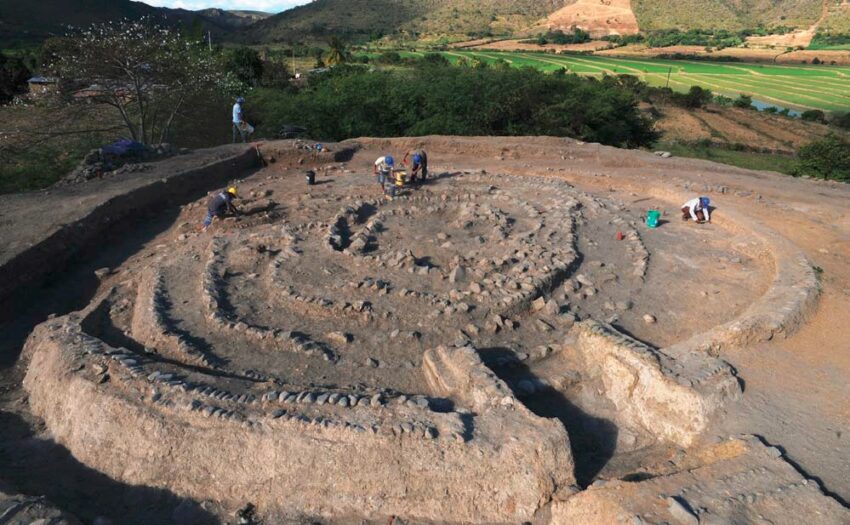Montegrande Peru is a significant archaeological site located in the Jequetepeque Valley. It’s known for its ancient temple complex, which dates back to the Formative Period of pre-Columbian history. The site gained attention for its monumental architecture and the discovery of a burial site, which included a cache of offerings and a female mummy. These findings suggest that Montegrande was a center of religious and ceremonial activities. The site provides valuable insights into the early development of complex societies in the Andes.
Get your dose of History via Email
Historical Background of Montegrande Peru
Montegrande Peru came into the limelight when researchers unearthed its secrets. The discovery happened in 2010, led by archaeologist Quirino Olivera. The site’s creators were the ancient Cupisnique culture, known for their influence in the Andean region. Montegrande’s history is rich, with later inhabitants including the Moche and the Inca. It was a hub of activity, shaping the cultural landscape of pre-Columbian Peru. The site’s significance lies in its longevity and the historical events it witnessed.
The Cupisnique culture, which thrived from approximately 1500 to 1000 BC, built Montegrande. This culture is one of the oldest in the Americas. They were known for their intricate ceramics and monumental architecture. Montegrande’s construction reflects the Cupisnique’s advanced understanding of engineering and religious devotion. The site’s architecture is a testament to their skill and influence.
Over time, Montegrande saw various cultures take residence. The Moche culture, which existed from about 100 AD to 800 AD, also left its mark on the site. The Inca, who later dominated the region, used Montegrande for their purposes. Each culture added layers to the site’s history, making it a palimpsest of Andean civilization.
Montegrande was not just a settlement but also a ceremonial center. The discovery of a female mummy suggests it was a site of religious importance. The burial site, with its offerings, indicates that rituals and ceremonies were a significant part of life here. These practices likely had a profound impact on the social and political structures of the time.
The site has also been a focal point for historical events. Its strategic location in the Jequetepeque Valley meant it was at the crossroads of trade and cultural exchange. Montegrande’s history is a narrative of the rise and fall of cultures, of innovation and tradition, and of the enduring human spirit.
About Montegrande Peru
Montegrande Peru is a marvel of ancient engineering and religious significance. The site consists of a temple complex with a central pyramid, plazas, and residential areas. The construction methods reflect the Cupisnique culture’s mastery of their environment. They used local materials, such as adobe bricks, to create their monumental structures.
The central pyramid stands as the heart of Montegrande. It’s a massive structure, built with millions of adobe bricks. The pyramid’s design is indicative of the Cupisnique’s religious and cosmological beliefs. The plazas surrounding the pyramid served as gathering spaces for the community, likely hosting various public events.
Residential areas at Montegrande show the site was more than a ceremonial center. It was a living community. The dwellings, built with the same adobe bricks as the temple, housed the people who maintained the site. These areas provide a glimpse into the daily lives of the ancient inhabitants.
Architectural highlights of Montegrande include intricate friezes and carvings. These artistic elements depict deities, animals, and symbols significant to the Cupisnique culture. The artistry found at Montegrande is a window into the spiritual world of its creators.
The construction of Montegrande is a testament to the Cupisnique’s architectural prowess. The site’s layout and design were carefully planned, aligning with astronomical events and natural features. This alignment underscores the importance of the natural world in Cupisnique religion and philosophy.
Theories and Interpretations
Montegrande Peru has sparked various theories about its use and significance. Some scholars suggest it was a religious and political center. Others believe it played a role in regional trade networks. The presence of a female mummy points to the possibility of female leadership or high-status women in Cupisnique society.
The site’s ceremonial aspects are a subject of interpretation. The offerings found in the burial site suggest that Montegrande was a place of worship and sacrifice. These practices may have been integral to the social cohesion of the community.
Mysteries still shroud Montegrande. The exact nature of the rituals and the identity of the deities worshipped remain elusive. The art and architecture provide clues, but much is left to the imagination and scholarly debate.
Historical records from later cultures, such as the Moche and Inca, help interpret Montegrande’s past. These records, combined with archaeological evidence, paint a picture of a dynamic and evolving site. However, gaps in the historical record leave room for speculation and further research.
Dating of Montegrande has been carried out using methods like radiocarbon dating. These techniques have helped establish a timeline for the site’s construction and use. The dating confirms Montegrande’s place in the Formative Period of Andean history.
At a glance
Country: Peru
Civilization: Cupisnique, Moche, Inca
Age: Formative Period, approximately 1500 to 1000 BC (Cupisnique): 100 AD to 800 AD (Moche): 1400s AD (Inca)

